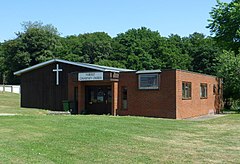A2W reactor
This article needs additional citations for verification. (September 2016) |
The A2W reactor is a naval nuclear reactor used by the United States Navy to provide electricity generation and propulsion on warships. The A2W designation stands for:
- A = Aircraft carrier platform
- 2 = Second generation core designed by the contractor
- W = Westinghouse was the contracted designer
History
This nuclear reactor was used in the world's first nuclear-powered aircraft carrier, the USS Enterprise (CVN-65). The four propulsion plants on Enterprise each contained two reactors, numbered according to the shaft they powered, 1A-1B, 2A-2B, 3A-3B, and 4A-4B. Each propulsion plant was capable of operating on one reactor plant through most of the power range required to propel the ship at speeds in excess of 33 knots (60 km/h). Both reactors would have been on-line to simultaneously provide maximum ship speed and plane launching capability.
Design and operation
The reactors are pressurized water reactors fueled by highly enriched (upwards of 93%) uranium-235.[1] Light water is used as both neutron-moderator and reactor coolant. Hafnium Control rods are used to control the operation of the reactor. Extracting the rods to a calculated height allows the reactor to reach criticality, the point at which the nuclear fission reactions reach a self-sustaining level. Thereafter, steam flow (from the steam generators) regulates reactor power as explained below. The control rods are "shimmed" in or out to regulate average coolant temperature or lowered to the bottom of the reactor vessel to shut the reactor down — either done in a slow controlled manner or dropped rapidly during what is called a SCRAM to immediately shut the reactor down in an emergency.
정상상태 운전 중 원자로 출력 제어의 대부분은 냉각수 음온계수의 결과로 발생한다. 원자로 출력은 연료에서 일어나는 핵분열 사건의 순간 속도에 의해 결정된다. 물이 가열되면 팽창하고 밀도가 낮아져 중성자를 중화하는 부피당 분자가 적어지기 때문에 필요한 열 에너지로 중성자가 느려져 열분열을 지속한다. 반대로 냉각수 온도가 감소하면 밀도가 높아지고 중성자의 수가 필요한 열 에너지에 도달하여 시간 단위당 배출 횟수가 증가하여 더 많은 열을 발생시킨다. 이는 원자로 출력을 제어하기 위한 '조종 수요'를 허용하는 효과가 있어 선박 운항이 요구하는 출력 변화에 원자로 운영자의 개입이 거의 필요하지 않다.
원자로에서 나오는 온수는 대형 파이프를 통해 증기발생기라 불리는 열교환기로 보내진다. 가압되고 과열된 원자로 냉각수로부터의 열은 튜브 벽을 통해 별도의 공급 시스템에서 증기발생기로 공급되는 물로 전달된다. A1W 및 A2W 시스템에서는 원자로냉각재수를 525~545°F(274~285°C)로 유지한다. 증기발생기에서 공급계통의 물은 535 °F (279 °C)에서 증기로 변환되며, 압력은 약 600 psi (4 MPa)이다. 일단 원자로냉각재수가 증기발생기에 열을 방출하면 대형 전기펌프(원자로당 4개)를 통해 원자로로 반환되어 순환을 반복한다.
600 psi에서의 포화 증기는 각 증기 발생기에서 공통 헤더로 채널화되며, 거기서 증기는 주 엔진, 전기 발전기, 항공기 포화 증기 시스템 및 다양한 보조 장치로 보내진다. 2개의 주추진 터빈, 1개의 고압 터빈과 1개의 저압 터빈이 있으며, 두 개의 터빈 사이에는 수분 분리기가 설치되어 있다. 저압 주 추진 터빈은 이중 엔드로 되어 있는데, 수증기가 중앙으로 들어가 실제 터빈 바퀴에 들어가면서 두 개의 하천으로 나뉘어 팽창하고, 그렇게 함으로써 에너지를 포기하여 터빈을 고속으로 돌리게 한다. 메인 샤프트는 터빈 샤프트의 높은 회전 속도가 선박을 추진하기 위해 사용 가능한 회전 속도로 내려가는 감속 기어로 들어간다. 주 엔진과 다른 보조장치에서 증기가 배출된 증기는 응축기로 들어가 액체로 냉각되고 공급 시스템에 재활용된다.
참조
- ^ Chunyan Ma; Frank von Hippel (Spring 2001). "Ending the Production of Highly Enriched Uranium for Naval Reactors" (PDF). The Nonproliferation Review. p. 87. Retrieved 20 February 2013.



